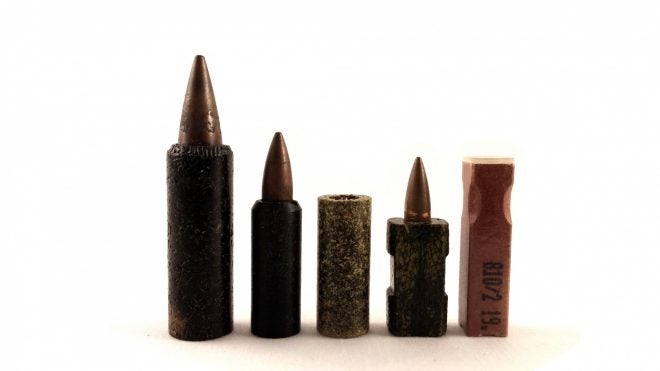Previously, we discussed trying to lighten the soldier’s load by making the cartridge case out of different materials, including aluminum and compositing the case out of polymer and metal. Yet, wouldn’t the lightest possible case configuration be… Having no case at all? That’s the thinking behind one of the most ambitious ammunition configurations there is, the case-less round.
Of course, it’s true that before the metallic cartridge case was invented, essentially all ammunition was caseless, but today the term “caseless” refers to ammunition that is self-contained, but with a body made of combustible propellant that directly contributes to sending the projectile out of the gun’s barrel. This concept is as elegant as it is simple; after all, making every part of the round work at killing the enemy can only be a good idea, right? Well, it’s not so simple as that, because economically producing caseless ammunition suitable for automatic weapons has proven to be an incredibly technically complex challenge. For starters, there’s a fundamental contradiction to the concept: Gun propellants need to expose a certain amount of surface area to igniting flame in order to work properly and have the correct burn rate, but a caseless round needs its propellant to be consolidated into a single solid chunk which is durable enough for storage, shipping, and field use. This requires some kind of “disintegrator” charge – which may be provided by the primer – that breaks up the consolidated propellant during ignition, increasing its surface area. Also, caseless ammunition lacks any protective barrier between the propellant and the chamber, which may be very hot after a string of fire. This lack of a protective envelope reduces the threshold at which ammunition cooks off inside the weapon, a serious concern for a military small arm. Finally, caseless ammunition also cannot gain the benefit of disposable breech sealing that comes built-in to the modern metallic cartridge, so sealing must be accomplished some other way. All of these problems are difficult at low production levels, and impossible at the volumes required for a modern military round.
In fact, these challenges are so great that it’s unlikely that the concept will become feasible within the next few decades. However, if the considerable technical challenges are somehow surmounted, caseless ammunition offers the maximum reduction in ammunition weight possible with conventional projectiles, while also facilitating extremely high rates of fire, due to the elimination of the extraction and ejection phases of the cycle.
And maybe caseless isn’t so far out of reach, either. From the 1970s to the 1990s, German engineers at Dynamit Nobel, working with those at Heckler & Koch, developed an extremely mature caseless round that, while not yet ready for service, brought the concept the closest its ever been to reality. Perhaps my reservations are just cynicism, and a practical, reliable caseless automatic weapon is nearer than we think…
 Your Privacy Choices
Your Privacy Choices
